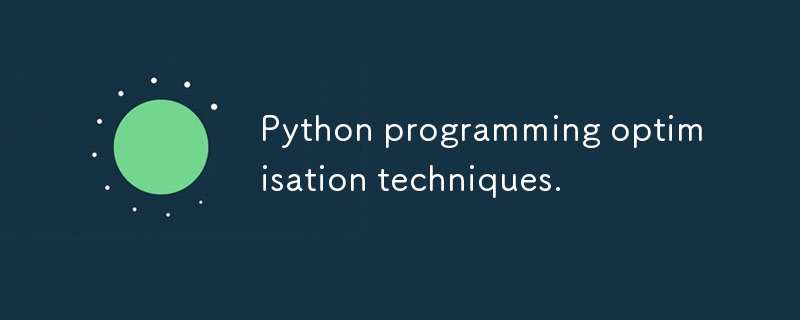

最適化されたコードはソフトウェアの効率、パフォーマンス、スケーラビリティに直接影響するため、不可欠です。適切に記述されたコードは、実行速度が速く、消費リソースが少なく、保守性が高いため、より大きなワークロードを処理し、ユーザー エクスペリエンスを向上させるのに適しています。また、効率的なコードには必要な処理能力とメモリが少なくなるため、運用コストも削減されます。これは、組み込みシステムや大規模なクラウド アプリケーションなど、リソースが限られている環境では特に重要です。
一方、コードの書き方が不十分だと、実行時間が遅くなり、エネルギー消費が増加し、インフラストラクチャのコストが増加する可能性があります。たとえば、Web アプリケーションでは、非効率なコードによりページの読み込みが遅くなり、ユーザー エクスペリエンスが低下し、ユーザーが離れていく可能性があります。データ処理タスクでは、非効率的なアルゴリズムにより大規模なデータセットの処理時間が大幅に増加し、重要な洞察や意思決定が遅れる可能性があります。
さらに、最適化されたコードは、多くの場合、保守と拡張がより簡単になります。最適化のベスト プラクティスに従うことで、開発者はコードベースをクリーンでモジュール化した状態に保つことができ、必要に応じてアプリケーションを更新したり拡張したりすることが容易になります。ソフトウェア プロジェクトが複雑になり、システムへの要求が増大するにつれて、これはますます重要になります。
より効率的でパフォーマンスの高いコードを作成するのに役立つ 10 の Python プログラミング最適化テクニックを見てみましょう。これらの手法は、パフォーマンス要件を満たしながら、長期間にわたって拡張性と保守性を維持できる堅牢なアプリケーションを開発するために不可欠です。これらのテクニックは、ベスト プラクティスに従うことで他のプログラミング言語にも適用できます。
変数パッキングは、複数のデータ項目を単一の構造にグループ化することでメモリ使用量を最小限に抑えます。この手法は、大規模なデータ処理など、メモリ アクセス時間がパフォーマンスに大きな影響を与えるシナリオでは重要です。関連データがまとめてパックされると、CPU キャッシュの使用効率が向上し、データの取得が高速化されます。
例:
この例では、struct モジュールを使用して整数をコンパクトなバイナリ形式にパックし、データ処理をより効率的にしています。
2.例:
リーリー
例:
リーリー
例:
リーリー
例:
リーリー
import numpy as np # Efficient matrix multiplication using NumPy matrix_a = np.random.rand(1000, 1000) matrix_b = np.random.rand(1000, 1000) result = np.dot(matrix_a, matrix_b)
Here, NumPy's dot function is enhanced for matrix operations, far outperforming nested loops in pure Python.
Short-circuiting reduces unnecessary evaluations, which is particularly valuable in complex condition checks or when involving resource-intensive operations. It prevents execution of conditions that don't need to be checked, saving both time and computational power.
Since conditional checks will stop the second they find the first value which satisfies the condition, you should put the variables most likely to validate/invalidate the condition first. In OR conditions (or), try to put the variable with the highest likelihood of being true first, and in AND conditions (and), try to put the variable with the highest likelihood of being false first. As soon as that variable is checked, the conditional can exit without needing to check the other values.
Example:
def complex_condition(x, y): return x != 0 and y / x > 2 # Stops evaluation if x is 0
In this example, Python’s logical operators ensure that the division is only executed if x is non-zero, preventing potential runtime errors and unnecessary computation.
In long-running applications, especially those dealing with large datasets, it’s essential to free up memory once it’s no longer needed. This can be done using del, gc.collect(), or by allowing objects to go out of scope.
Example:
import gc # Manual garbage collection to free up memory large_data = [i for i in range(1000000)] del large_data gc.collect() # Forces garbage collection
Using gc.collect() ensures that memory is reclaimed promptly, which is critical in memory-constrained environments.
In systems where memory or bandwidth is limited, such as embedded systems or logging in distributed applications, short error messages can reduce overhead. This practice also applies to scenarios where large-scale error logging is necessary.
Example:
try: result = 10 / 0 except ZeroDivisionError: print("Err: Div/0") # Short, concise error message
Short error messages are useful in environments where resource efficiency is crucial, such as IoT devices or high-frequency trading systems.
Loops are a common source of inefficiency, especially when processing large datasets. Optimising loops by reducing iterations, simplifying the logic, or using vectorised operations can significantly improve performance.
Example:
import numpy as np # Vectorised operation with NumPy array = np.array([1, 2, 3, 4, 5]) # Instead of looping through elements result = array * 2 # Efficient, vectorised operation
Vectorisation eliminates the need for explicit loops, leveraging low-level optimisations for faster execution.
By applying these techniques, you can ensure your Python or other programming language programs run faster, use less memory, and are more scalable, which is especially important for applications in data science, web and systems programming.
PS: you can use https://perfpy.com/#/ to check python code efficiency.
以上がPython プログラミングの最適化テクニック。の詳細内容です。詳細については、PHP 中国語 Web サイトの他の関連記事を参照してください。